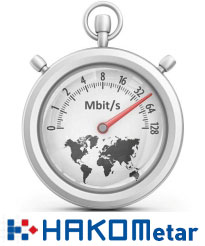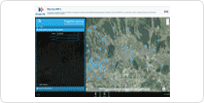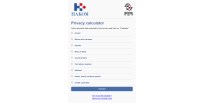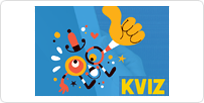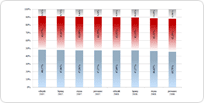Hakom - Croatian Post and Electronic Communications Agency
e-Agency
Users:
Cost Estimator
The Holder of Framework Programme
GIS portal
Privacy calculator
Application ''Quiz''
Market survey
International Agreements on Digital Television Frequency Allocation Concluded
NEWSZagreb, December 14, 2017 – In the recent years the technology development has brought a new and more efficient digital TV system DVB-T2 as well as a new and more efficient coding system H.265 / HEVC. In order to enable economical transmission of high definition television content ("HD") in terrestrial networks and facilitate the development of new services, it is necessary to switch to a more efficient DVB-T2 system with H.265 / HEVC video encoding. The DVB-T2 system with comparable reception conditions offers greater flexibility and up to 50% higher transmission capacity compared to the DVB-T system. By means of introducing new standards it is possible to use the radio frequency spectrum more efficiently and take advantage of a smaller spectrum to transmit existing channels or improve their quality, thus releasing the radio frequency spectrum of second digital dividends for services in mobile networks.
The ever increasing demands of broadband Internet access users in the larger area require ever greater amounts of spectrum, which is naturally limited. Taking into consideration propagation characteristics (characteristics of spreading radio frequency signals) and economic cost-effectiveness, the most suitable radio frequency spectrum for broadband access is the bandwidth of about 1 GHz for coverage of larger areas and frequency bands 2-5 GHz for additional capacities in urban, densely populated areas . These frequency ranges have already been used for various other radio communication services and their conversion can only be achieved by optimizing existing systems, in this case digital television, which in practice means switching the entire system to DVB-T2 technology with the H.265 / HEVC coding system.
In order to complete the transition process as smoothly as possible and harmonized, the draft of the Digital Terrestrial Television Switchover Strategy to the DVB-T2 system and the 700 MHz bandwidth will be in the process of defining a specific timeline for switching to DVB- T2 with H.265 / HEVC encoding. The DVB-T2 - H.265 / HEVC system is expected to broadcast high-definition content ("HD") to all national coverage programs.
In July this year, HAKOM published the „Recommendation on minimum receiver technical requirements for the reception of DVB-T and DVB-T2signal in the Republic of Croatia which represents the minimum technical requirements DVB-T2 receivers need to satisfy in order to ensure high quality in the Republic of Croatia services of digital terrestrial television available for public acceptance.
The transition to the DVB-T2 standard is expected after the expiration of the existing permits for multiplex digital terrestrial television starting in 2019. In the period 2019-2021, citizens will need to adapt their reception equipment to the new standard (the so-called STB- Set Top Box devices). When selecting a new TV / receiver, it will be important to support the DVB-T2 system and H.265 / HEVC coding system and comply with the Recommendation. If citizens are buying a new TV receiver in the meantime, which is not necessary before changing standards in the period 2019-2021, it is advisable to pay attention to the standard to avoid additional costs or receivers in the future.
The completion of the second digital dividend allocation for services in mobile communications networks in most EU Member States is expected by June 30, 2020. The publication of the Recommendation is one of the pre-conditions for marking a DVB-T2 receiver with a special logo which will guarantee compliance with the broadcasting standard in Croatia and make it easier for consumers to buy. The choice of the logo, as well as the prescribing of the receiver certification process for the Croatian market, is planned in 2018.
In order to ensure all the preconditions for moving to a new standard, it is necessary to harmonize the technical parameters of the specific transmitters at the international level as well. Due to the geographic position and the relief of the Republic of Croatia, international harmonization is carried out primarily with Austria, Albania, Bosnia and Herzegovina, Montenegro, Italy, Hungary, Slovenia and Serbia. The replacement of the 470-790 MHz frequency band using the digital television, and the 694-790 MHz bandwidth for mobile networks in Europe has started to be negotiated at the level of regional groups (10 neighbouring countries). The Republic of Croatia participated in two groups:
- the region on the Adriatic and Ionian Sea - Albania, Montenegro, Greece, Croatia, Italy, Slovenia and San Marino - The agreement was signed on October 4, 2017.
- SEDDIF (South European Digital Dividend Implementation Forum) - Austria, Albania, Bosnia and Herzegovina, Bulgaria, Montenegro, Greece, Croatia, Hungary, Macedonia, Romania, Slovenia, Serbia, Turkey and Ukraine - 5 and 6 December 2017 framework agreement as well as bilateral agreements with neighbouring countries in the group.
At the last SEDDIF meeting in Budapest, negotiations between neighbouring states on harmonization of frequency and technical parameters of transmitters in future digital television networks were completed after which bilateral agreements were signed - The Republic of Croatia with Austria, Bosnia and Herzegovina, Montenegro, Hungary, Slovenia and Serbia. Also, the framework agreement of all countries within SEDDIF group was signed. The channel synchronization process at this meeting has been completed, starting in 2015.
The said agreements have not yet been signed by Albania and San Marino.
The signing of these agreements means that the Republic of Croatia and all neighbouring countries have agreed on the distribution of television channels, thereby creating the preconditions for a successful planned transition to DVB-T2 and the release of the spectrum of other digital dividends for the provision of broadband services in mobile communications networks.
In addition, demands by the European Commission have been met that all agreements within the European Union should be completed by the end of 2017.
At the international level, it will still be necessary to agree on the parameters for the broadcasters of the local television, which is planned in 2018.
Finally, taking into account all the above mentioned the adoption of the Strategy will give full technical and economic conditions and the transition of parameters to the DVB-T2 - H.265 / HEVC system resulting with the release of the band 694-790 MHz. This radio frequency spectrum will be allocated for public mobile communications networks which will further contribute to the state budget of the Republic of Croatia, and operators will be provided with the necessary additional spectrum resources so that all citizens of Croatia can deliver a high- quality broadband Internet service.
# # #
For additional information please contact:
Croatian Regulatory Authority for Network Industries (HAKOM)
Roberta Frangeša Mihanovića 9
10110 Zagreb, Croatia
Tel. + 385 (0) 1 700 70 07
Fax + 385 (0)1 700 70 70
Media inquiries can be submitted online using HAKOM’s official website:
Registration required.
ABOUT HAKOM: HAKOM (www.hakom.hr) - Croatian Regulatory Authority for Network Industries – ensures preconditions for a fair market competition, stable growth and environment for innovations in the electronic communications and postal services market. HAKOM protects users’ interests and the possibility of choice among various communications and postal services at affordable prices, defines sustainable competitive conditions for operators and service providers under fair conditions for return on investment, and provides support to economic growth, public services and the quality of life in the Republic of Croatia by using modern technologies. HAKOM’ strategic goals are: to promote regulation of the electronic communications and postal services market, to support growth of investments and innovations in the electronic communications and postal services market, to provide efficient use of limited resources, to accelerate the growth of broadband products and services, to provide affordable offers of communications and postal services, to provide protection and informing of users, to build an efficient and comprehensive information system, to define and implement efficient processes, and to acquire multi-disciplinary competencies in market regulation.


